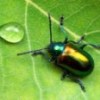
Tribolium castaneum, the Red Flour Beetle
Here's a beetle that the genetics-inclined entomologist will recognize. Tribolium castaneum, the red flour beetle, was the first Coleopteran to have its genome sequenced.
This small tenebrionid is native to the Indo-Australian region but has become a pest of stored grains around the world. I photographed these individuals from a lab culture at the University of Arizona where they were being used in studies on beetle development.

Photo details: Canon MP-E 65mm 1-5x macro lens on a Canon EOS 20D
ISO 100, f/13, 1/250 sec, diffused flash
More like this
I've posted enough Friday Beetles that I can no longer remember which species I've already done. Some species were almost posted twice out of sheer forgetfulness. Must be the academic scatter-brain.
tags: pets, insects, beetles,
I've heard of "carrion beetles" but this is more like a "carry-on beetle":

Well that's just silly. They don't even look like flour...
Seriously, these are splendid shots! That second photo especially intrigues me with the texture being so visible--especially of the eyes.